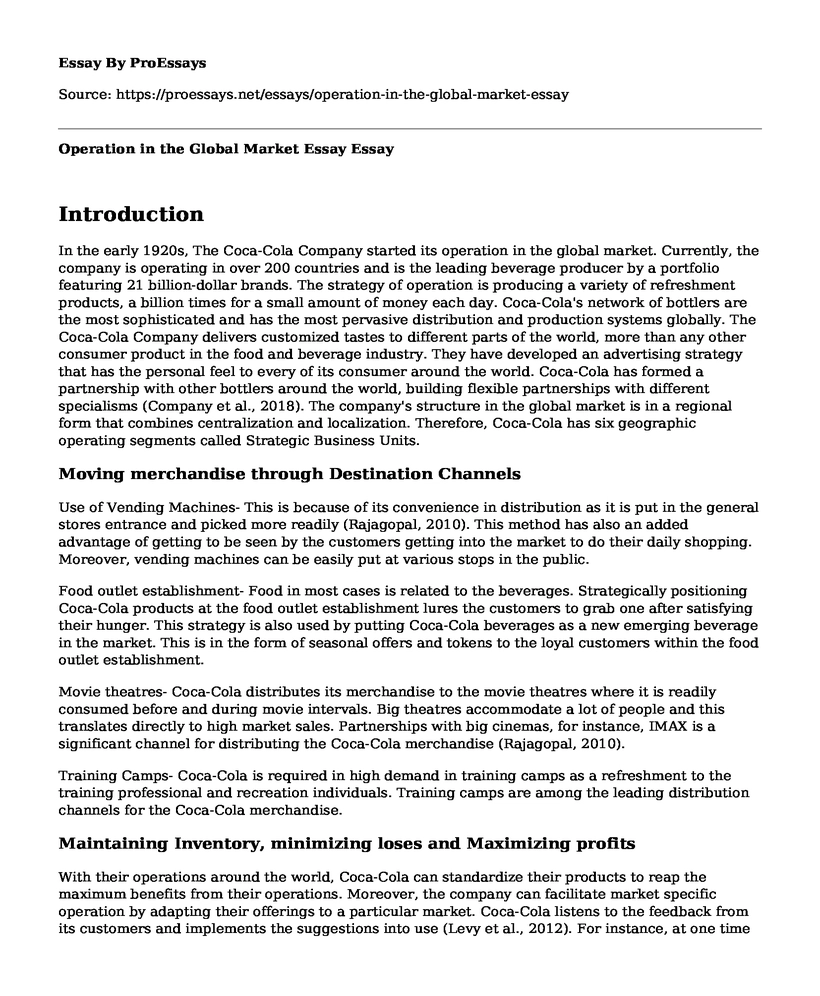Introduction
In the early 1920s, The Coca-Cola Company started its operation in the global market. Currently, the company is operating in over 200 countries and is the leading beverage producer by a portfolio featuring 21 billion-dollar brands. The strategy of operation is producing a variety of refreshment products, a billion times for a small amount of money each day. Coca-Cola's network of bottlers are the most sophisticated and has the most pervasive distribution and production systems globally. The Coca-Cola Company delivers customized tastes to different parts of the world, more than any other consumer product in the food and beverage industry. They have developed an advertising strategy that has the personal feel to every of its consumer around the world. Coca-Cola has formed a partnership with other bottlers around the world, building flexible partnerships with different specialisms (Company et al., 2018). The company's structure in the global market is in a regional form that combines centralization and localization. Therefore, Coca-Cola has six geographic operating segments called Strategic Business Units.
Moving merchandise through Destination Channels
Use of Vending Machines- This is because of its convenience in distribution as it is put in the general stores entrance and picked more readily (Rajagopal, 2010). This method has also an added advantage of getting to be seen by the customers getting into the market to do their daily shopping. Moreover, vending machines can be easily put at various stops in the public.
Food outlet establishment- Food in most cases is related to the beverages. Strategically positioning Coca-Cola products at the food outlet establishment lures the customers to grab one after satisfying their hunger. This strategy is also used by putting Coca-Cola beverages as a new emerging beverage in the market. This is in the form of seasonal offers and tokens to the loyal customers within the food outlet establishment.
Movie theatres- Coca-Cola distributes its merchandise to the movie theatres where it is readily consumed before and during movie intervals. Big theatres accommodate a lot of people and this translates directly to high market sales. Partnerships with big cinemas, for instance, IMAX is a significant channel for distributing the Coca-Cola merchandise (Rajagopal, 2010).
Training Camps- Coca-Cola is required in high demand in training camps as a refreshment to the training professional and recreation individuals. Training camps are among the leading distribution channels for the Coca-Cola merchandise.
Maintaining Inventory, minimizing loses and Maximizing profits
With their operations around the world, Coca-Cola can standardize their products to reap the maximum benefits from their operations. Moreover, the company can facilitate market specific operation by adapting their offerings to a particular market. Coca-Cola listens to the feedback from its customers and implements the suggestions into use (Levy et al., 2012). For instance, at one time there was an introduction of a new formula that the consumers disliked. As a result, Coca-Cola responded swiftly and reinstated the original formula so that the loyal customers are not lost (Rajagopal, 2010). Moreover, through the Strategic Business Units, Coca-Cola is able to understand global markets are separated geographically, lifestyle-regarding income and consumption patterns- and the taste is not the same in all areas, markets are not in the same developmental stages. Coca-Cola has a system of organizing the employees into units. Consequently, the employees feel valued leading to a high throughput maximizing profits. A friendly, innovative lifestyle offered to the Coca-Cola employees by the managing directors ensure even more inventory is in place (Demetris & Lain, 2003).
References
Company, O., Main, O., Journey, A., Mission, V., Inclusion, D., & Rights, H. et al. (2018). A Global Business. Retrieved from https://www.coca-colacompany.com/stories/the-chronicle-of-coca-cola-a-global-business
Demetris, V., & Lain, S. (2003). The Market Review (3rd ed., pp. 289-309). Westburn Publishers Limited.
Levy, M., Weitz, B., & Beitelspacher, L. (2012). Retailing management. New York: McGraw-Hill Irwin.
Rajagopal. (2010). Consumer behavior. New York: Nova Science Publishers.
Cite this page
Operation in the Global Market Essay. (2022, Jun 06). Retrieved from https://proessays.net/essays/operation-in-the-global-market-essay
If you are the original author of this essay and no longer wish to have it published on the ProEssays website, please click below to request its removal:
- Knowledge of Globalization and Sociocultural/Cognitive Approaches
- Course Work Example: Communication in the Workplace
- Product Usability Study: Coffee Machine
- Terrorism Liaison Officer's Decision Making Video Analysis
- Paper Example on Innovation and Competitive Advantage: Changing Environments
- Essay on Shanghai Baby: Gender, Market and Consumer Culture in Chinese Cities
- Expatriate Employees: Rewarding for Successful Overseas Branches - Essay Sample







